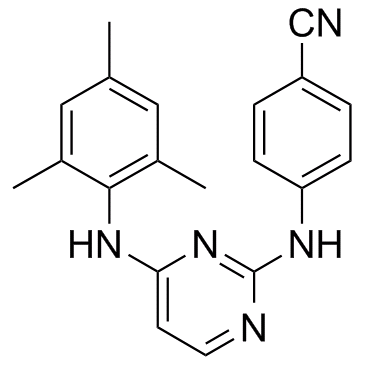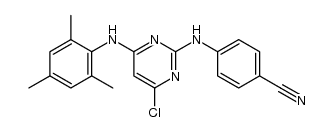Dapivirine (TMC120)

Dapivirine (TMC120) structure
|
Common Name | Dapivirine (TMC120) | ||
|---|---|---|---|---|
| CAS Number | 244767-67-7 | Molecular Weight | 329.398 | |
| Density | 1.2±0.1 g/cm3 | Boiling Point | 557.9±60.0 °C at 760 mmHg | |
| Molecular Formula | C20H19N5 | Melting Point | N/A | |
| MSDS | N/A | Flash Point | 291.2±32.9 °C | |
Use of Dapivirine (TMC120)Dapivirine(TMC 120, TMC 120 R147681) is a NNRTI for HIV reverse transcriptase with IC50 of 24 nM, inhibits a broad panel of HIV-1 isolates from different classes, inclucing a wide range of NNRTI-resistant isolates.IC50 value: 24 nM [1]Target: HIV reverse transcriptase; NNRTIsin vitro: TMC120-R147681 is a diarylpyrimidine with high activity against wild-type and mutant HIV. A 24-h treatment with 1,000 nM UC-781 or 100 nM TMC120-R147681 prevented cell-free HIV infection, whereas 10-fold-higher concentrations blocked cell-associated HIV, TMC120-R147681 apparently blocked infection in the primary cultures at a 10 nM concentration, but secondary cultures revealed that a 100 nM concentration was needed to completely prevent proviral integration [1]. Dapivirine is well tolerated by epithelial cells, T cells, macrophages, and cervical tissue explants with CC50 (50% cytotoxic concentration) of 10 μM to 20 μM. Dapivirine potently inhibits infection by both X4- and R5-utilizing HIV-1 strains with IC50 of 1.46 nM in cell-based assays. Dapivirine potently inhibits HIV-1BaL infection of human ectocervical explant tissue in a dose-dependent manner, as evaluated by the reduction in both p24 release and provirus content in cultured explants. Dapivirine inhibits the transmission of virus to permissive T cells in a dose-dependent manner, with an IC50 of 0.1 nM. Dapivirine results in significant inhibition of HIV infection when explants are challenged with virus immediately with IC90 of 100 nM. Dapivirine is also able to inhibit viral dissemination by migratory cells [2].in vivo: Dapivirine-containing gel at vaginal level inhibits cell-associated HIV infection in mice [3]. More placebo (7 of 12) than Dapivirine (3 of 24) gel users has positive vaginal swab results, with white blood cells being the most common finding. Dapivirine (0.05%) results in Cmax of 715 pg/mL, AUC of 15 ng×h/mL and T1/2 of 89.87 hours in plasma after 14 days post-dose. Mean Dapivirine (0.05%) concentrations in vaginal fluids collected at the introitus, mid vagina, and cervix are in the range of 62-265 μg/g on day 1 [4]. |
| Name | 4-[[4-(2,4,6-trimethylanilino)pyrimidin-2-yl]amino]benzonitrile |
|---|---|
| Synonym | More Synonyms |
| Description | Dapivirine(TMC 120, TMC 120 R147681) is a NNRTI for HIV reverse transcriptase with IC50 of 24 nM, inhibits a broad panel of HIV-1 isolates from different classes, inclucing a wide range of NNRTI-resistant isolates.IC50 value: 24 nM [1]Target: HIV reverse transcriptase; NNRTIsin vitro: TMC120-R147681 is a diarylpyrimidine with high activity against wild-type and mutant HIV. A 24-h treatment with 1,000 nM UC-781 or 100 nM TMC120-R147681 prevented cell-free HIV infection, whereas 10-fold-higher concentrations blocked cell-associated HIV, TMC120-R147681 apparently blocked infection in the primary cultures at a 10 nM concentration, but secondary cultures revealed that a 100 nM concentration was needed to completely prevent proviral integration [1]. Dapivirine is well tolerated by epithelial cells, T cells, macrophages, and cervical tissue explants with CC50 (50% cytotoxic concentration) of 10 μM to 20 μM. Dapivirine potently inhibits infection by both X4- and R5-utilizing HIV-1 strains with IC50 of 1.46 nM in cell-based assays. Dapivirine potently inhibits HIV-1BaL infection of human ectocervical explant tissue in a dose-dependent manner, as evaluated by the reduction in both p24 release and provirus content in cultured explants. Dapivirine inhibits the transmission of virus to permissive T cells in a dose-dependent manner, with an IC50 of 0.1 nM. Dapivirine results in significant inhibition of HIV infection when explants are challenged with virus immediately with IC90 of 100 nM. Dapivirine is also able to inhibit viral dissemination by migratory cells [2].in vivo: Dapivirine-containing gel at vaginal level inhibits cell-associated HIV infection in mice [3]. More placebo (7 of 12) than Dapivirine (3 of 24) gel users has positive vaginal swab results, with white blood cells being the most common finding. Dapivirine (0.05%) results in Cmax of 715 pg/mL, AUC of 15 ng×h/mL and T1/2 of 89.87 hours in plasma after 14 days post-dose. Mean Dapivirine (0.05%) concentrations in vaginal fluids collected at the introitus, mid vagina, and cervix are in the range of 62-265 μg/g on day 1 [4]. |
|---|---|
| Related Catalog | |
| References |
| Density | 1.2±0.1 g/cm3 |
|---|---|
| Boiling Point | 557.9±60.0 °C at 760 mmHg |
| Molecular Formula | C20H19N5 |
| Molecular Weight | 329.398 |
| Flash Point | 291.2±32.9 °C |
| Exact Mass | 329.164032 |
| PSA | 73.63000 |
| LogP | 3.98 |
| Vapour Pressure | 0.0±1.5 mmHg at 25°C |
| Index of Refraction | 1.649 |
| Storage condition | -20°C |
| Hazard Codes | Xi |
|---|
|
~% 
Dapivirine (TMC120) CAS#:244767-67-7 |
| Literature: Bioorganic and Medicinal Chemistry Letters, , vol. 23, # 18 p. 5213 - 5216 |
|
~% 
Dapivirine (TMC120) CAS#:244767-67-7 |
| Literature: Bioorganic and Medicinal Chemistry Letters, , vol. 23, # 18 p. 5213 - 5216 |
|
~% 
Dapivirine (TMC120) CAS#:244767-67-7 |
| Literature: Bioorganic and Medicinal Chemistry Letters, , vol. 23, # 18 p. 5213 - 5216 |
| Precursor 3 | |
|---|---|
| DownStream 0 | |
| 4-{[4-(Mesitylamino)-2-pyrimidinyl]amino}benzonitrile |
| 4-({4-[(2,4,6-trimethylphenyl)amino]pyrimidin-2-yl}amino)benzenecarbonitrile |
| Dapivirine (TMC120) |
| TMC120 |
| Benzonitrile, 4-[[4-[(2,4,6-trimethylphenyl)amino]-2-pyrimidinyl]amino]- |
| R-147681 |
| 4-[[4-[(2,4,6-trimethylphenyl)amino]-2-pyrimidinyl]amino]benzonitrile |
| UNII: TCN4MG2VXS |
| Dapivirine |
| 4-{[4-(Mesitylamino)pyrimidin-2-yl]amino}benzonitrile |
| UNII-TCN4MG2VXS |
| dapivirinum |

![4-[(4,6-Dichloropyrimidin-2-yl)amino]benzonitrile structure](https://image.chemsrc.com/caspic/239/329187-59-9.png)
